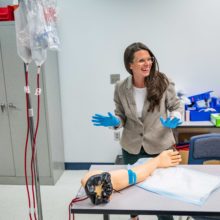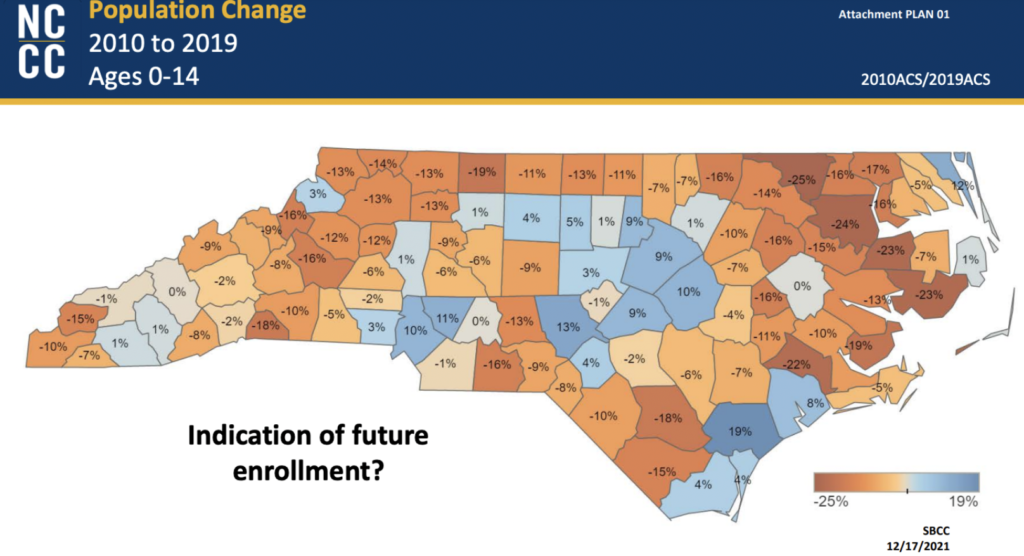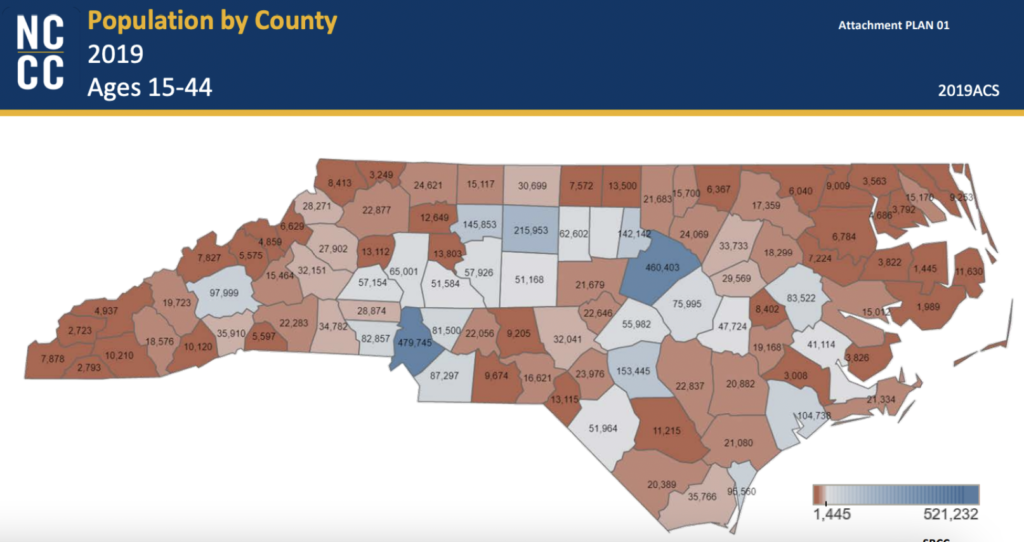|
|
Members of the State Board of Community Colleges met for the last time in 2021 on Dec. 16-17. It was a full two days of tying up loose ends, reflecting on the past year, and thinking about the year ahead.
During Friday’s meeting, the Board welcomed two new members and announced several personnel appointments.
Terry Van Duyn and Dr. Ray Russell are the newest members on the State Board. Van Duyn is a former member of the North Carolina Senate, where she represented District 49 from 2014 to 2021. Russell is a former professor at Appalachian State University and a former member of the North Carolina House of Representatives, where he represented the 93rd House District from 2018-2020.
Dr. Patty Pfeiffer was announced as Wayne Community College‘s new president. Pfeiffer has served as the college’s interim president since Dr. Thomas Walker’s departure in July 2021. Pfeiffer has been an employee of Wayne Community College since 1994, first as a faculty member and later as the vice president for academic and student services.
Dr. Levy Brown from Vance-Granville Community College will serve as the new senior vice president and chief academic officer at the North Carolina Community College System (NCCCS) office. Dr. Kim Gold previously served in the role Brown is filling. Gold is now the chief of staff for the system office.
Friday’s meeting was also a time of recognition.
System president Thomas Stith recognized the retirement of Maureen Little, former vice president of economic development for the NCCCS office. Little served the state for 33 years.
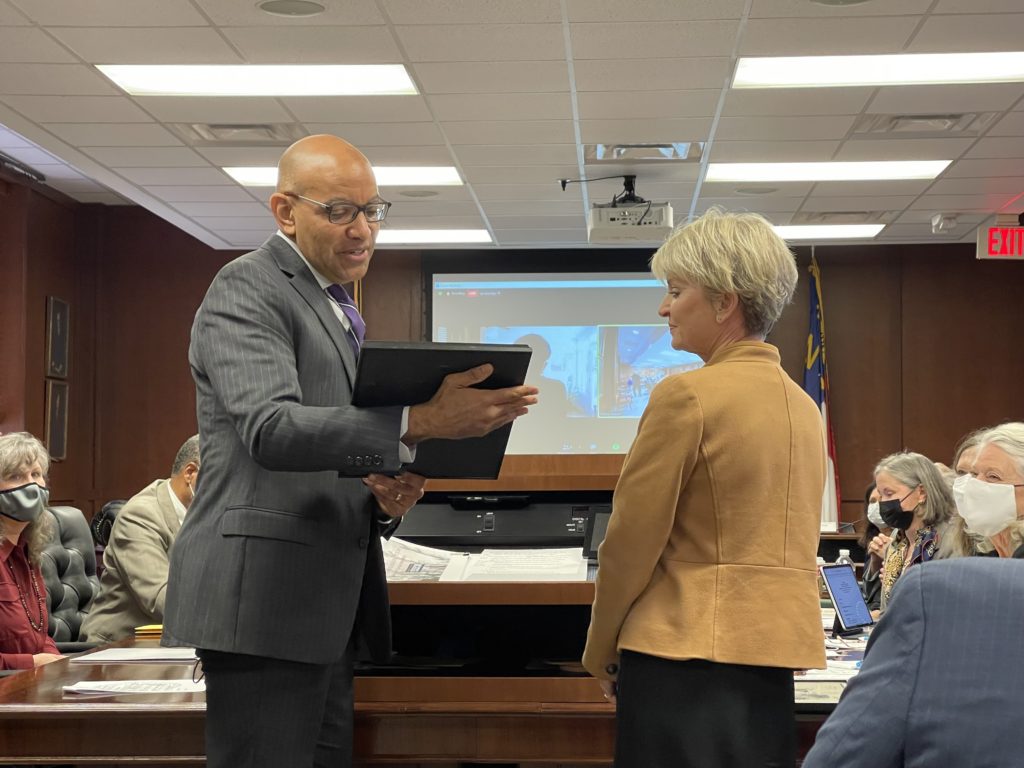
Stith also presented Little with the Order of the Long Leaf Pine award. It’s an award of the highest honor given by North Carolina’s governors to “persons who have made significant contributions to the state and their communities through their exemplary service and exceptional accomplishments.”
Other items from the Board meeting include an extensive presentation about enrollment insights across the state, approval for community colleges to proceed with paying the required salary increases in their Jan. 2022 payrolls, a glimpse at a three-year legislative plan, and more.
Enrollment insights
Since 2010, North Carolina community colleges have experienced declining enrollments — although there have been some exceptions, including a 6% enrollment bump in 2019. But by fall 2020, enrollment across the system had fallen 11%, with the pandemic largely to blame.
Almost 15 years of data shows that population shifts could be a major factor contributing to enrollment decline.
Bill Schneider, associate vice president of research and performance management at the system office, said that enrollment shifts at North Carolina community colleges have largely aligned with population shifts.
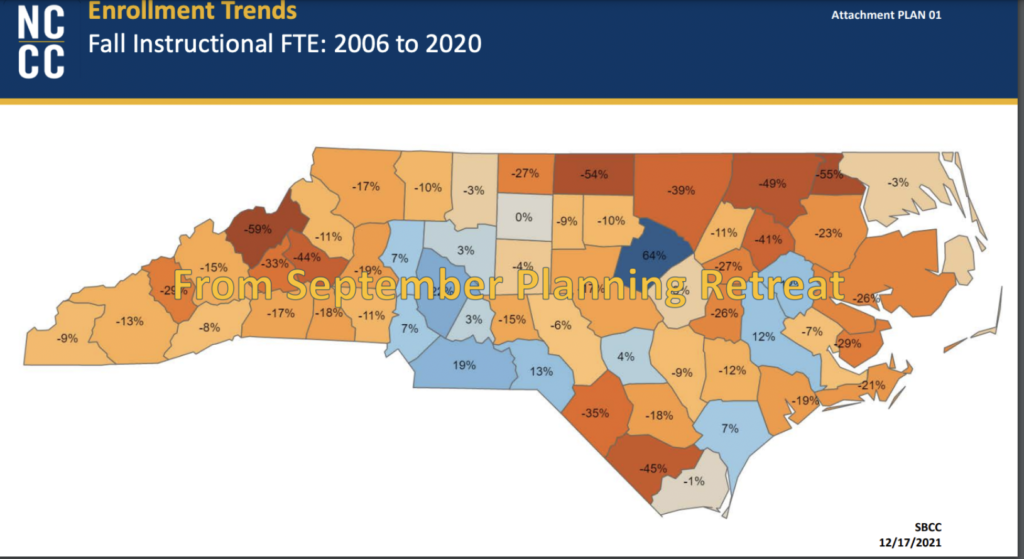
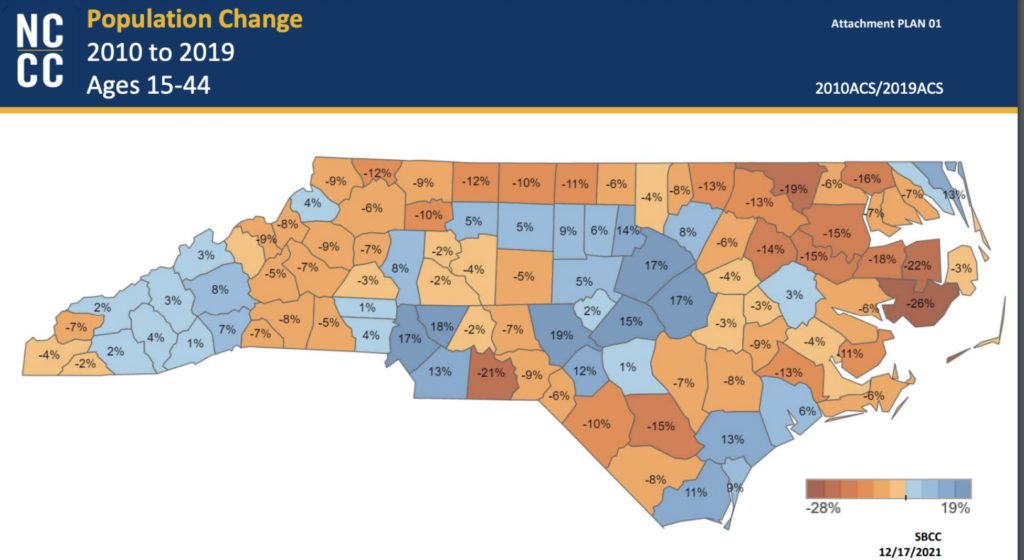
Counties with declining populations generally experience enrollment declines while counties with population growth tend to see enrollment growth.
According to Schneider’s report, 46 of the 58 colleges had FTE shifts that aligned with population shifts. FTE, or full-time equivalent students, is one way community colleges measure enrollment. Community colleges are also largely funded based on FTE.
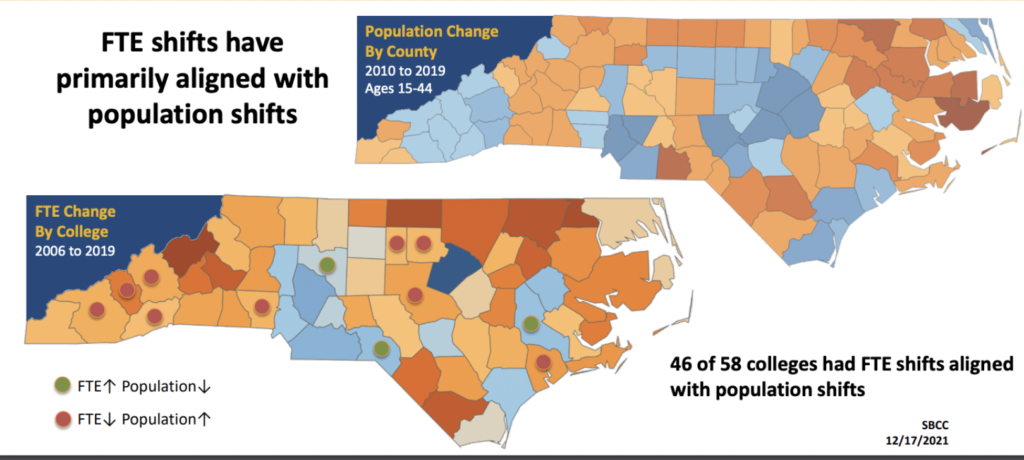
Three community colleges experienced FTE increases even though the county they serve saw population declines.
Schneider said if you look at population changes of those aged 0-14 and population by county of 15-44 year-olds, you can make the assumption that more rural schools will continue to see declining enrollments compared to urban schools.

Slide from Enrollment Insights Presentation
at State Board meeting
Slide from Enrollment Insights Presentation
at State Board meeting
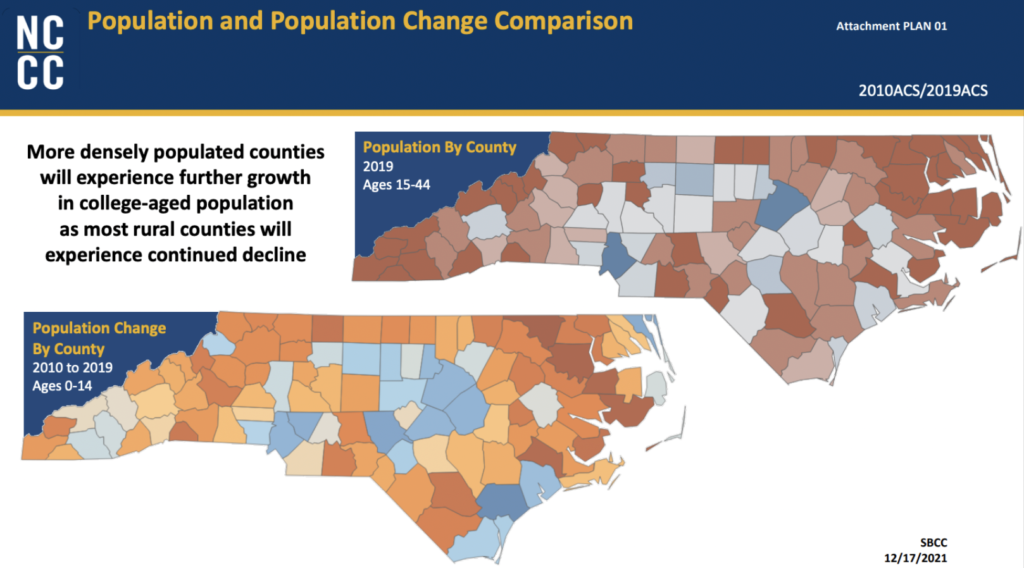
There is an untapped opportunity, according to Schneider. And it’s a population that has been a buzzword in recent months – adult learners.
As of 2019, only 6% of North Carolina’s population of 25-to-39 year-olds were enrolled in a community college. Of those students, 3% were enrolled in noncredit courses and the other 3% in credit courses. If you expand the age range to include ages 25-44, only 5% of North Carolina’s population is enrolled in a community college.
Schneider shared a comparison between community college enrollment rate and educational attainment among 25-44 year-olds. Generally speaking, counties with a lower percentage of population with some college or more had a higher community college enrollment rate. Similarly, counties with a higher percentage of population with some college or more had a lower community college enrollment rate.
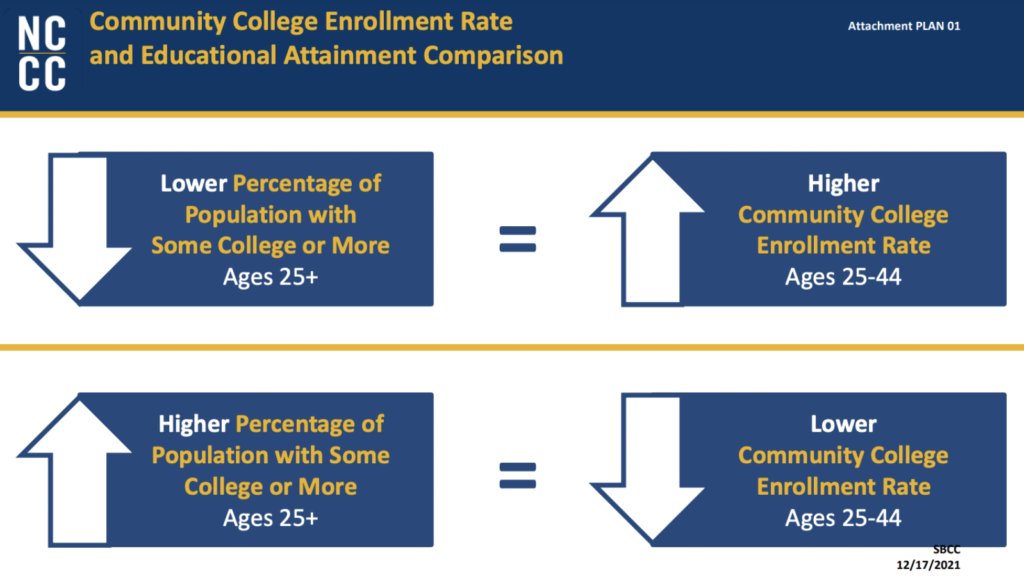
But there are outliers across the state.
Two community colleges had high community college enrollment rates and above-average educational attainment rates.
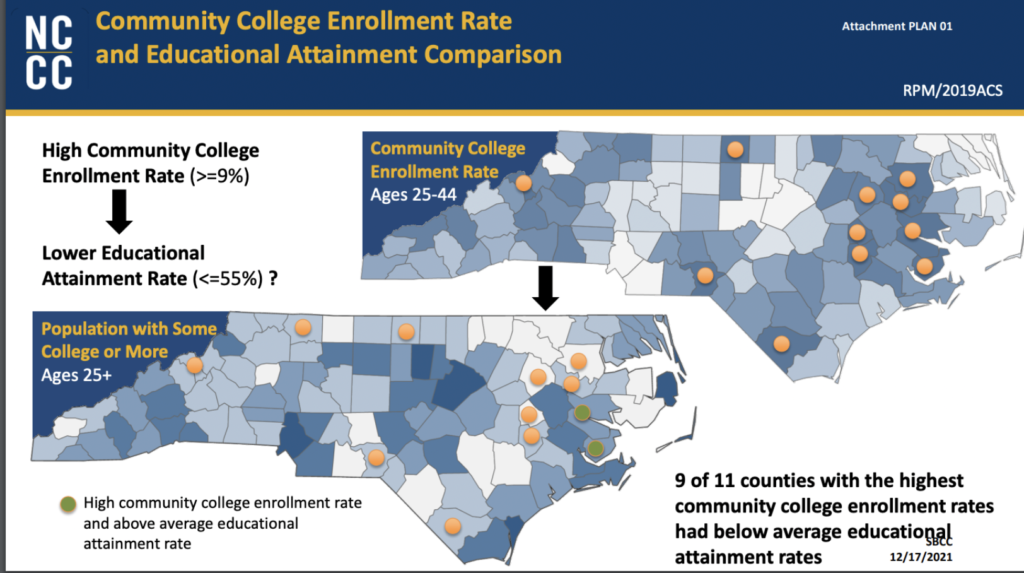
And four community colleges had high educational attainment rates and above-average community college enrollment rates.
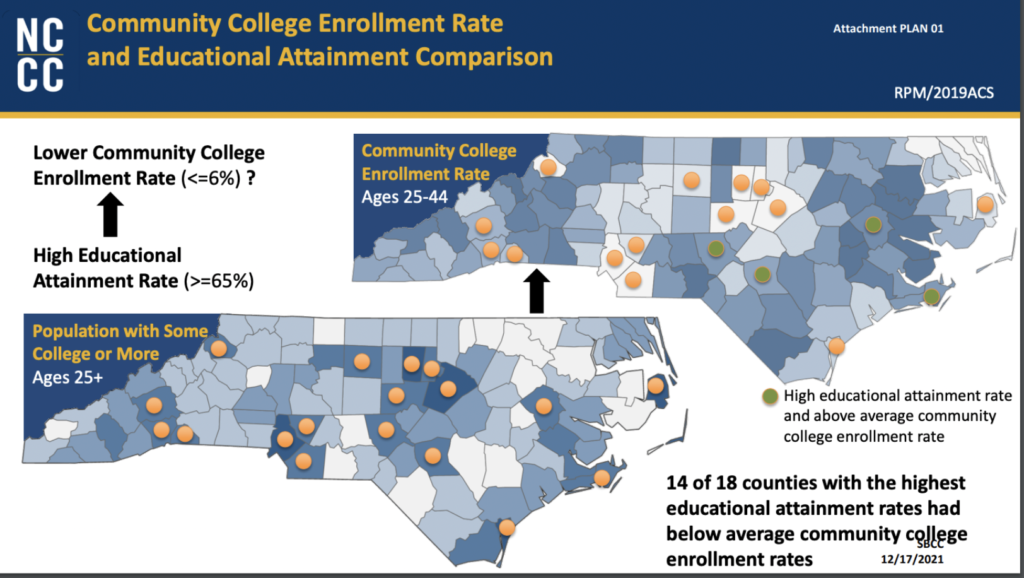
You can view the full presentation here.
Following the enrollment insights presentation, Dr. Monty Hickman, associate director of student success support services at the NCCCS office, provided Board members with an update from the Strategic Enrollment Management (SEM) Taskforce.
The taskforce was established in 2019 to help colleges better understand enrollment management and is made up of system office staff and individuals from community colleges across various departments.
Hickman said the taskforce works as consultants, visiting and creating dialogue across the state to determine high-impact enrollment strategies that can be shared with institutions in need of enrollment support.
The taskforce also includes external partners like Ruffalo Noel Levitz (RNL). RNL is a consulting group that helps colleges with strategic enrollment planning, student recruitment, retention, and more.
According to Hickman, RNL is offering complimentary strategic enrollment management analysis to six community colleges: Alamance Community College, Central Piedmont Community College, Guilford Technical Community College, Haywood Community College, Roanoke-Chowan Community College, and Western-Piedmont Community College. The colleges were selected based on size, location, and enrollment decline.
The first analysis begins Jan. 2022.
When will community college employees receive their salary increases and bonus?
The new state budget includes a 5% salary increase for community college personnel over the next two years. Salaries will increase 2.5% in the first year of the biennium, with an effective date of July 1, 2021, and another 2.5% starting July 1, 2022.
The budget also provides funds to raise the minimum wage of state-funded employees to $13 an hour in the first year of the biennium and $15 an hour in the second year.
The state budget directs that the increases be paid effective Jan. 1, 2022 (beginning in the January 2022 payroll). According to Board documents, “the amount of the legislative salary increase from July 1, 2021 to Dec. 31, 2021 will be paid in the form of a bonus equal to the authorized legislative salary increase for one-half of the fiscal year.”
In a normal budget year, the system office compiles a document with state aid allocations and budget policies and brings it before the Board for approval in August. But the Nov.18 signing of the state budget left little time for system office staff to prepare the document for the Board’s December meeting. Additionally, the system office is still waiting on guidance from the Office of State Budget and Management, Office of State Human Resources, and Office of State Controller on the implementation of the pay increases.
Elizabeth Grovenstein, vice president and chief financial officer at the system office, said the document should be ready by the next board meeting, which is scheduled for Jan. 20-21, 2022.
Since increases are to be paid in the January 2022 payroll, community colleges expressed concern about their authority to give the required salary increases without the Board’s approval of the state aid allocations and budget policies document.
The Board approved community colleges to implement the legislative mandate for salary increases and to follow the guidance issued by the system office.
The Board also voted to give Stith the ability to allocate funds for bonuses that were included in the state budget.
Full-time state and local education employees will receive a one-time bonus to be paid by Jan. 31, 2022. Full-time employees making less than $75,000 a year will receive a $1,500 bonus. Those who earn more than $75,000 annually will receive a $1,000 bonus.
The system office does not currently have data on how many community college employees are eligible to receive the bonus. A survey template was sent to all 58 community colleges for this data. Colleges were to return the information by end of day Dec. 17.
According to Board documents, “if the actual cost exceeds the amount appropriated, the System Office will need to request additional funds from the Office of State Budget and Management (OSBM) State Fiscal Recovery Fund Reserve.”
Priorities for the next budget
Planning is already underway for the next budget. The North Carolina Association of Community College Presidents (NCACCP) met Dec. 15 and unanimously approved the 2022-2025 legislative plan. The plan will now go before the North Carolina Association of Community College Trustees (NCACCT) for approval in early January.
The plan includes two major components: expanding capacity at community colleges and investments for staff and faculty salaries.
Chair of the legislative committee for the NCACCP and president of Richmond Community College, Dr. Dale McInnis, called the legislative plan a bold ask.
McInnis said the committee is wrapping up a survey from all 58 colleges that captures the quantitative and qualitative data to support their request for expanding capacity and making an investment in faculty and staff salaries.
Salaries have long been an issue at North Carolina community colleges. EdNC reported on salaries before the release of the Senate budget. But capacity is also a challenge across the state.
McInnis described capacity as the ability for colleges to expand services and programs. He further explained capacity by using the colleges’ small business centers as an example.
“We get funding at each college for basically one small business center,” McInnis said. “But if you’ve got multiple counties or a large urban county, one small business director is insufficient for you to be able to meet the economic development needs and small business growth your community requires.”
The Board will hear more about the three-year legislative plan at their January meeting.
Audits, cybersecurity officers, broadband expansion, and listening sessions
During Thursday’s issues luncheon, the Board heard from state auditor Beth Wood. Wood discussed the role of the state auditor’s office and the types of audits the office conducts.
Board member Lisa Estep asked Wood what the Board should focus on with respect to internal audits.
Wood named three areas: evaluating the efficiency of community colleges, ensuring the quality of courses taught, and making sure FTE (full-time equivalent) isn’t being abused in any way so that some community colleges are getting more money than they should be.
You can read more about FTE and how it is used to fund community colleges here.
The state budget allocates funding to hire nine regional IT security and compliance manager positions. These positions will assist community colleges in preventing and responding to cyberattacks.
During the personnel committee, Board member Tom Looney said the system will need to think outside the box when it comes to recruiting these positions noting that IT positions are difficult to fill.
If it proves too difficult to hire the nine, the suggestion was made that the system may need to consider increasing salaries and hiring fewer regional cybersecurity manger positions. The current salary for each regional manager position is set at $110,000.
Funding for broadband expansion was also included in the state budget. The budget allocated $15 million in non-recurring funds to increase broadband access at 25 rural community colleges.
The Board approved a contract amendment of up to $750,000 with the Friday Institute who will identify the 25 rural colleges and provide support services for the broadband access. The Friday Institute previously helped the system identify 20 rural colleges for broadband access using criteria based on “regional economy, student assistance, percentage of population served, and demand for technical assistance.” The same criteria will be used to identify an additional 25 rural colleges.
The North Carolina Community College System is in the process of developing their new strategic plan. To aid in the process, the State Board of Community College is holding nine regional listening sessions around the state, one of which will be conducted virtually for those who cannot attend an in-person meeting.
Patrick Crane, vice president of strategic initiatives at the NCCCS office, said for each listening session they have invited between five and ten colleges. Each college was asked to send a five-person team that included the president, chair and vice-chair of the Board of Trustees, additional trustees, and members of the college leadership team, including Student Government.
According to Crane, the listening sessions provide an opportunity for college leaders to share the biggest challenges facing their college and region and promising practices to address them. It also gives a chance for the System office and State Board to understand how they can best support the colleges.
The first listening session took place on Dec. 8 at Pitt Community College. The remaining listening sessions will be held in January and February.
The next State Board meeting is scheduled for Thursday, Jan. 20, 2022 and Friday, Jan. 21, 2022 in the Dr. W. Dallas Herring State Board Room located in the Caswell Building in Raleigh, NC.
